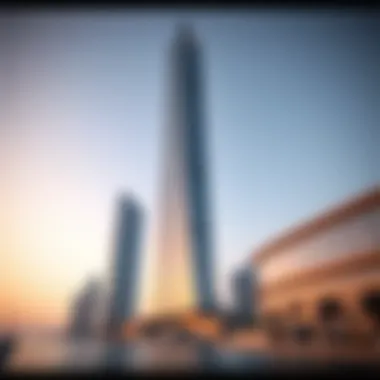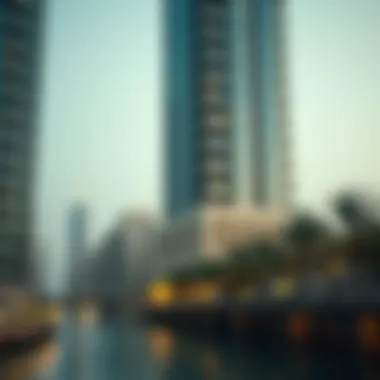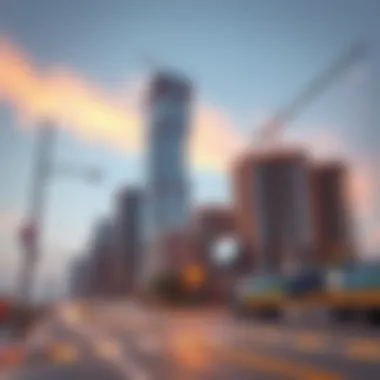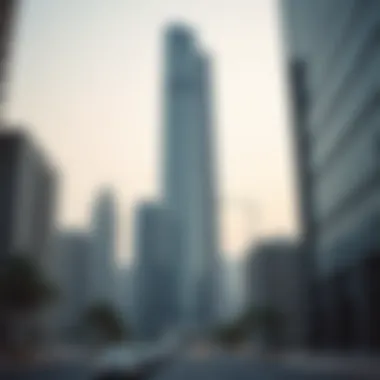The Status of Dubai Creek Tower: Halting Progress and Implications


Intro
Dubai Creek Tower, initially envisioned as a monumental addition to the skyline of this thriving metropolis, is currently in a state of indefinite suspension. This ambitious project aimed to surpass even the illustrious Burj Khalifa, raising both excitement and expectations within the architectural realm. However, with construction halted, stakeholders are left pondering what this means for the future of the city’s skyline and its real estate landscape.
In this article, we will dissect the causes behind the suspension of Dubai Creek Tower, its ramifications on Dubai's real estate market, and how it may influence architectural progression in the region moving forward. This analysis seeks to equip investors, real estate agents, homeowners, and developers with knowledge that can aid in navigating the complexities of a rapidly changing environment.
Understanding the current state of development and anticipating future possibilities is crucial. As the market reacts to this unexpected halt, we will explore significant metrics and trends shaping the investment strategies in Dubai's real estate scene.
Understanding Dubai Creek Tower
The Dubai Creek Tower, once envisioned to be a symbol of modern architecture and a beacon of progress for Dubai, stands at a crucial juncture in its development. This section elucidates the significance of understanding the structure itself, which encapsulates not only the ambitious dreams of a city but also acts as a mirror reflecting the economic, cultural, and architectural aspirations of the region. By delving into this project, one can appreciate the interconnections of urban development and its impact on various stakeholders, from investors to aspiring homeowners.
Historical Context
To comprehend the current standing of Dubai Creek Tower, it’s imperative to trace its historical background. The concept of the tower was announced in 2016, during a period when Dubai was revamping its skyline. Inspired by the iconic Burj Khalifa, this structure was designed by the renowned architect Santiago Calatrava. Unlike its predecessor, the Dubai Creek Tower intended to blend seamlessly with nature, borrowing elements from the region’s traditional architecture.
One cannot overlook the timing of this announcement. Coinciding with Dubai's push towards becoming a global hub for tourism and commerce, the tower as a landmark was aimed at attracting a new influx of visitors. However, as construction progressed under the shadows of economic fluctuations and global uncertainties, it became clear that merely having a grand vision does not guarantee success.
Architectural Vision
The architectural ambition behind the Dubai Creek Tower is profound. Intended to reach a soaring height of over 1,000 meters, it was promoted as the tallest structure in the world, setting a precedent for future developments in Dubai. The design, inspired by the lily flower, symbolizes growth and resilience. Calatrava’s vision attempts to harmonize form and function, with a focus on sustainability and environmental sensitivity. The tower was not just about height; it was also about creating a unique experience for visitors and residents alike. With observation decks promising breathtaking views of the Gulf, the structure aimed to become an iconic attraction, merging aesthetics with practical use.
Expected Features
While the blueprints of Dubai Creek Tower enchant many, the expected features highlight its unique character and appeal further:
- Multi-functional Spaces: Designed to host residential, commercial, and hospitality spaces.
- Observation Decks: Noteworthy levels designed to offer panoramic views of Dubai's skyline and Arabian Gulf.
- Green Technology: Intended inclusion of sustainable technologies like solar energy systems and rainwater harvesting.
- Cultural Integration: Reflecting local culture through its design, enhancing community connection.
Ultimately, the Dubai Creek Tower isn't just a building; it's a transformative vision of a modern metropolis seeking to intertwine tradition with innovative design.
"Architecture is not just about aesthetics; it’s about creating experiences that elevate communal pride and identity."
The Current Status of Construction
The construction progress of the Dubai Creek Tower holds significant weight in understanding its future trajectories and implications for the city's architectural landscape. This phase is a crucial indicator not only of the project's viability but also the broader economic health of the area. The tower has been envisioned as a symbol of ambition, and any stalling re-evaluates Dubai's readiness to maintain its reputation as a beacon of modern engineering.
Official Statements on the Halt
The official communications regarding the halt of the Dubai Creek Tower project highlight the complexities involved. Both the developer and the architectural firms involved have released statements emphasizing that this pause is not the end, but rather, a necessary phase to ensure sustainability and effectiveness. During a press conference, a representative from Emaar Properties remarked, "We are committed to making sure that the final product aligns with the original vision without compromise."
These insights shed light on the cautious yet optimistic approach taken by stakeholders. It's essential to discern that during such pauses, entities often reassess their strategies, exploring avenues to enhance the project both economically and environmentally.
Timeline of Development
Mapping out the timeline of Dubai Creek Tower's development reveals a series of milestones, punctuated by challenges. Initially announced in 2016, construction began with great fanfare and ambitious expectations. The subsequent years saw incremental progress, with several significant achievements, including the groundbreaking ceremony and initial structural frameworks.
However, as global economic conditions fluctuated, so did the timelines. Here’s a brief overview:


- 2016: Project announcement and design completion.
- 2017: Groundbreaking and the start of preliminary construction work.
- 2018-2019: Initial structural progress.
- 2020: COVID-19 pandemic affects construction pace.
- 2021-Present: Official pause, with no definitive resumption date communicated.
Understanding these dates helps investors and analysts contextualize the current situation within a historical framework, emphasizing the need for adaptability in such mega-project undertakings.
Key Players Involved
The stakeholders involved in the Dubai Creek Tower project read like a who's who of the construction and architectural world. Central to this endeavor are:
- Emaar Properties: The developer leading a significant portion of Dubai's iconic projects.
- Stanton Williams: The architectural firm responsible for the tower's imaginative and cutting-edge design.
- Various Contractors and Investors: These include both local and international firms, which contribute not only funding but also expertise in construction practices.
This project's success hinges on the collaboration among these key players. As each entity navigates through this tumultuous period, their ability to maintain communication and strategic direction will influence the project’s revival.
"In large-scale constructions, every halt can be a double-edged sword; it presents hurdles but also the chance to rethink and innovate."
In light of current events, these players are under immense scrutiny, not just from stakeholders but from the public, who are keenly interested in what the future holds for this ambitious project and, by extension, the city of Dubai itself.
Reasons for the Project's Suspension
The suspension of Dubai Creek Tower has piqued interest beyond the borders of the UAE, and the importance of this topic cannot be overstated. Understanding the reasons behind the halt not only sheds light on the current predicament of the tower but also provides valuable insights into broader economic, regulatory, and technological challenges facing super-tall structures in cities around the globe. Investors, real estate agents, homeowners, developers, and market analysts alike can glean critical information from an examination of these factors, guiding their future decisions in the evolving landscape of Dubai’s ambitious developments.
Economic Factors
Firstly, the economic landscape plays a pivotal role in the status of construction projects like Dubai Creek Tower. With the ripple effects from fluctuations in oil prices impacting the Gulf economies significantly, the financial viability of such grand designs comes into question. The initial enthusiasm surrounding the tower's construction faced headwinds as economic growth slumped, leading to a cautious approach from investors and stakeholders.
- Funding Challenges: Aspects like securing financing have become more complex. Investors are increasingly wary, looking for assurance that their capital is safeguarded against economic downturns. Thus, many are reassessing their commitments amid tightening budgets.
- Market Demand Fluctuation: The real estate market has felt the impact of changing buyer sentiment, especially with concerns over oversupply. The once booming luxury property market in Dubai shows signs of saturation, leading to a dip in demand. This economic shift can thwart plans for extravagant projects if the predicted returns are not justifiable.
Economic considerations, encompassing these elements, highlight the precarious balance that developers attempt to maintain amidst globalization and regional instability.
Regulatory Concerns
Next up are the regulatory hurdles that plague such high-profile projects. The construction industry carries with it a slew of regulations, ensuring projects are not only feasible but also in alignment with sustainability standards and local zoning laws. In the case of Dubai Creek Tower, several regulatory concerns came to the forefront, contributing to the suspension.
- Zoning Restrictions: Local authorities continuously revisit land use across the Dubai architecture landscape, which means that controllers must often assess the fit of such massive constructions within existing city plans. This ongoing reassessment can cause delays and lead to alterations in the projected design.
- Safety Regulations: As with any tall structure, safety is paramount. The technologies and materials used must comply with stringent safety protocols. Delays in adjustments to adhere to evolving safety standards can consequently halt progress while industry professionals ensure that every aspect is faultless.
These regulatory challenges serve as crucial reminders of the need for alignment with local laws and standards that can impose significant ramifications on ambitious projects.
Technological Challenges
Finally, technological advancements can be a double-edged sword in the construction of skyscrapers. The Dubai Creek Tower, designed to become a landmark, relies on cutting-edge techniques for its realization. However, these innovations can also serve as a stumbling block.
- Construction Techniques: The strive for architectural marvels demands the latest in construction technology. However, implementing these groundbreaking techniques often requires time, skilled labor, and resource allocation that can stretch current capabilities thin. Such challenges may slow progress and even force a reassessment of the construction timelines.
- Supply Chain Disruptions: The tumultuous global supply chain has affected numerous industries. Materials essential for completing technologically advanced buildings face delays or unexpected shortages that directly influence project timelines.
Impact on Dubai's Real Estate Market
The halt in construction of the Dubai Creek Tower carries significant weight in the real estate market of Dubai. This tower was not just another addition to the skyline; it was touted to redefine it, attracting high-profile investors and tourists alike. With the suspension of this ambitious project, stakeholders must grapple with an evolving landscape that could either present challenges or unexpected opportunities. The implications of this halt range from shifts in market sentiment to alterations in investment strategies. Understanding these elements is crucial for buyers, sellers, and investors.
Market Sentiment Analysis


Market sentiment plays a crucial role in the dynamics of the real estate sector. The suspension of Dubai Creek Tower has sparked a shift in how investors and potential buyers perceive the market. Initially, the project was synonymous with prestige, progress, and unyielding growth. However, with its current state, sentiments have significantly dimmed.
Many real estate analysts suggest that the trust in Dubai as a groundbreaking hub may waver. Surveys show a growing apprehension among potential investors, who fear that the delay in high-profile projects could signal deeper issues within the local economy. For instance, potential buyers may hesitate to invest in properties nearby until there is clarity on the future of the tower and its associated developments.
Key points regarding market sentiment include:
- Tendency toward caution among investors
- Increased demand for flexibility in property negotiations
- Rise of alternative investment options as confidence diminishes
"When a flagship project like Dubai Creek Tower hits the brakes, it sends shockwaves through the local market. Investors often seek surety, and uncertainty typically breeds caution."
Investor Reactions
Investor responses to the construction suspension offer a mirror to market health and confidence. Many investors have revisited their portfolios, weighing the risks associated with investments linked to major projects like Dubai Creek Tower. The domino effect here is palpable; when investor confidence dips, so does market fluidity.
Reactions span across multiple spectrums:
- Diversification: Some investors are beginning to pull back and are opting for a more diversified portfolio, delving into varied segments such as residential, commercial, and even international markets.
- Waiting: Others have chosen to adopt a 'wait-and-see' approach, choosing to hold off on new investments until further clarity emerges regarding the project's status.
- Opportunities in Distress: Meanwhile, a select group of investors sees potential in this chaos, considering it a ripe opportunity to scoop up undervalued properties as owners may be forced to sell at lower prices.
Comparative Developments
In light of the Dubai Creek Tower predicament, comparing it against other developments can shed light on potential outcomes. Projects often face various challenges, and learning from others can inform strategies moving forward.
- One Za'abeel: This project faced its own halts yet managed to bounce back, reaffirming investor faith over time.
- Burj Khalifa: Despite its initial hurdles, it has since proven to be a massive attraction, showcasing how eventual success can change the narrative around halted projects.
- Dubai Marina: The development faced slowdowns during the financial crisis but has since thrived, posing a roadmap for recovery.
From these examples, it can be inferred that while the current halt might seem detrimental, history has shown that resilience can lead to eventual success. The challenge remains for Dubai Creek Tower to implement a robust future strategy that will not only see its completion but also redefine expectations within the broader architectural and real estate markets of the city.
Future Prospects for Dubai Creek Tower
The future of the Dubai Creek Tower is not just a matter of personal interest; it holds significant implications for Dubai and the architectural world at large. Understanding the potential pathways for this towering structure is not only crucial in gauging the direction of Dubai’s skyline, but it also provides insights into investment dynamics, economic recovery, and strategic planning in urban development. A topic of this nature sheds light on a larger narrative—preserving aspirations amid challenges.
Possible Resumption Scenarios
There are several possible scenarios for the resumption of construction on Dubai Creek Tower, each breaking down the complexities involved:
- Financial Restructuring: If the economic climate stabilizes, there’s potential for investors to step in with fresh capital, allowing construction to continue. This could follow a pattern similar to how other halted projects have reignited.
- Public-Private Partnerships: Involving government stakeholders might open doors for alternative funding mechanisms. A collaboration between private developers and the authorities could usher in the necessary support to resume work.
- Evolving Technology: As technology advances, new methodologies may emerge, making previously unimaginable designs feasible. If a technological breakthrough occurs, it could lay the groundwork for a redesigned tower, enhancing both efficiency and safety measures.
These scenarios, while speculative, highlight that the possibility of resuming construction is not entirely out of reach. The key lies in adaptive planning and a proactive approach to problem-solving.
Long-term Vision for Dubai's Skyline
Looking beyond the immediate pause, the long-term vision for Dubai's skyline depends heavily on iconic structures like the Dubai Creek Tower. It represents not just a single structure, but a commitment to pushing boundaries in urban design.
- Architectural Landmark: As the centerpiece of the Dubai Creek Harbour development, the tower’s resumption would play a vital role in the area’s identity, eclipsing existing structures in both height and futuristic architecture.
- Tourism and Economic Growth: Projects like these draw tourists, and with them, economic growth. A completed tower could attract millions, contributing to both local and national revenue streams.
- Sustainable Urban Growth: Dubai’s ambition for a more sustainable city can also leverage the designs of the tower. Prospective plans may include renewable energy features or environmentally-friendly materials, setting a benchmark for future constructions.
In essence, revitalization of the project can contribute significantly to the vision for Dubai as a thriving metropolis that embraces both tradition and innovation.
Lessons Learned from Similar Projects


Other architectural ventures that have faced delays or complications offer valuable lessons relevant to Dubai Creek Tower:
- Understanding Market Demand: The Burj Khalifa's resounding success was due in part to its initial conception, which aligned well with market demand. Future initiatives should prioritize market analysis and stakeholder feedback to gauge public interest accurately.
- Managing Expectations: Observing how high-profile projects like the Hudson Yards in New York City navigated financial hurdles demonstrates the need for realistic timelines and clear communication. Transparency can foster trust with investors and the public alike.
- Regulatory Flexibility: The Doha Metro project in Qatar highlights the importance of working with local government bodies to navigate regulations effectively. A flexible approach in adapting to changing governance can mitigate significant delays.
"Navigating the uncertainties in large-scale projects often reveals paths to innovation, proving that it’s not just about the finished structure, but the journey of creation itself."
In summary, the future prospects for the Dubai Creek Tower are layered and multifaceted. Consideration of potential scenarios, coupled with lessons drawn from previous projects, presents opportunities for a promising outcome. The realization of this towering ambition would not only mark another feather in Dubai’s architectural cap but could redefine the city’s trajectory amid the challenges that urban development faces today.
The Broader Architectural Landscape
The construction of Dubai Creek Tower, despite its current suspension, remains a beacon of what the future of architecture may look like. Understanding the broader architectural landscape is essential not just for grasping the implications of this halt but also for discerning the evolving dynamics within which such monumental projects will exist. This section delves into overarching trends in urban development, the disruptions introduced by the pandemic, and the innovative designs emerging in the Middle East region, setting the stage for a deeper examination of the architectural future.
Trends in Urban Development
As cities around the globe continue to expand, the trends shaping urban development become increasingly pronounced. One key trend is the push towards sustainable architecture, which focuses on minimizing environmental impact while maximizing utility and aesthetic appeal. Developers are now looking beyond mere functionality, seeking to integrate nature into urban settings through green spaces and eco-friendly materials. Notably, approaches such as biophilic design are gaining traction, enhancing occupants' connection to nature.
Furthermore, smart city technologies are being embraced to improve livability and efficiency. As urban centers become more populated, data-driven solutions can optimize everything from traffic patterns to energy consumption. This intersection of technology and urban planning signals a shift in how future projects like the Dubai Creek Tower could be envisioned and executed. Architects and developers are now required to design spaces that are responsive not just to human needs but also to the environment and technology integration.
Impact of COVID-19 on Architectural Projects
The COVID-19 pandemic has reshaped many sectors, and architecture is no exception. As public health and safety take precedence, designs are now incorporating features that promote social distancing and hygiene. Designs for public spaces have become more adaptable, allowing easier modifications based on changing circumstances.
In the context of Dubai Creek Tower, this pandemic-induced shift means re-evaluating building materials, airflow systems, and communal spaces. Architects are challenged to create environments that accommodate future health concerns while remaining aesthetically pleasing. For example, concepts like touchless technology in building entry points and improved ventilation systems are becoming more desirable. This is a direct response to enhancing occupant comfort and health, revolutionizing the architectural landscape moving forward.
Innovative Designs in the Region
In the midst of these changes, the Middle East, particularly the UAE, stands at the forefront of architectural innovation. A myriad of projects are redefining skylines and exploring bold structural possibilities. From the intricate designs of the Museum of the Future in Dubai to the gravity-defying forms seen in contemporary skyscrapers, creativity knows no bounds.
Innovative designs aren’t restricted to aesthetics; they often solve complex engineering challenges. For instance, the use of advanced materials and construction techniques is prevalent, which allows for previously impossible structures to rise. Furthermore, culturally reflective designs integrate local heritage with modern functionality, making them not only innovative but also meaningful.
"As the architectural landscape evolves, it is not just about building taller or faster; it is about creating spaces that resonate with their environment and the people who inhabit them."
This vision is what makes the Dubai Creek Tower and similar projects so vital to the ongoing transformation of urban architecture in the region. In sum, the broader architectural landscape encompasses more than just isolated projects; it reflects a collective shift towards sustainability, health-conscious designs, and innovative engineering that is sure to impact how future edifices, including those on hold like the Dubai Creek Tower, are perceived and executed.
Closure
The conclusion of this article serves as a precise anchor that collates the exploration of Dubai Creek Tower's status, anchoring our discussions on the critical elements emerging from its halt. It's a pivotal reflection, emphasizing not just the raftered architectural ambitions behind the tower but also the broader implications for the city of Dubai and its stakeholders.
Summary of Key Insights
As we reach the close of our examination, several key insights emerge:
- Economic Viability: The delay in construction invites scrutiny regarding the financial aspects of the project, including funding sources and economic conditions spurring hesitation among investors.
- Architectural Significance: An insight into how architectural ambitions ebb and flow in response to economic realities highlights the fragile balance between visionary designs and practical execution.
- Regulatory Landscape: The complexity of legal and regulatory hurdles faced gives a lens into how projects of this magnitude cannot progress without navigating a web of compliance and approvals.
- Stakeholder Preparedness: The reactions of investors and the market have been telling, shedding light on the need for preparedness and adaptability in the midst of uncertainty.
These insights underscore that the completion or further suspension of the Dubai Creek Tower is not merely a standalone issue; rather, it interlinks with the pulse of the economy, investor sentiment, and future architectural endeavors in the region.
Implications for Stakeholders
The implications of the halted progress of Dubai Creek Tower stretch widely across various stakeholder groups:
- Investors must rethink their strategies and approaches, considering risk management in light of halted developments. The stalling forces a reevaluation of timelines and projected returns.
- Developers face a pressing need to shift focus to other ongoing projects or adapt their strategies until the construction resumes, ensuring that their portfolios remain robust and relevant.
- Real Estate Agents may experience a cooling interest in the proximity surrounding the tower, necessitating a change in how they market properties in that area.
- City Planners and policymakers are reminded of the importance of a responsive regulatory framework that can protect ambitious projects while providing necessary support during turbulent times.
-> Ultimately, the status of Dubai Creek Tower highlights an essential lesson in the interconnectedness of investment, regulatory environments, and urban development. As we await decisions and developments, stakeholders must stay informed and ready to adapt to the changing landscape.











